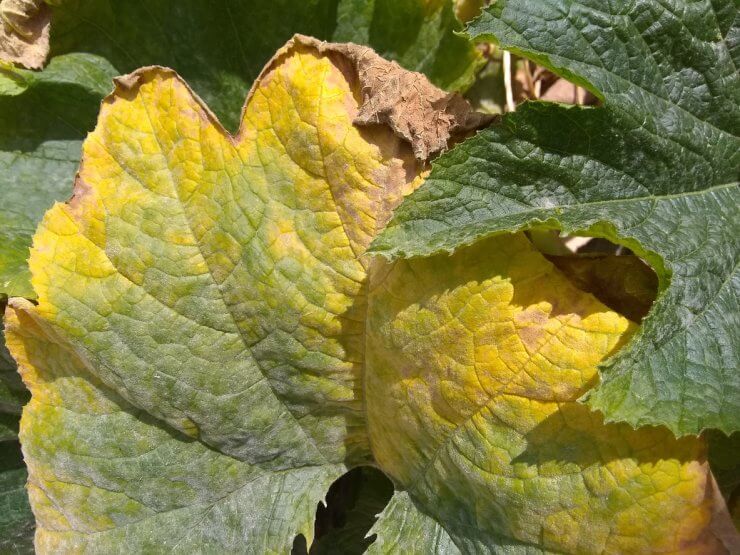
Diseased squash leaf
Like all food crops, winter squash are susceptible to various fungal diseases. Your strongest weapons against these are best planting practices, which help prevent disease in the first place.
This is especially important, as there are no fungicides approved for home use for many diseases.
These best practices are aimed at producing strong, healthy plants that can withstand disease, and at avoiding situations that contribute to the development of disease. They involve keeping plants clean, dry, and undamaged.
Watering: Water your winter squash deeply about once a week (check the soil for dryness). Do not over-water. Soggy soil invites disease. Focus on watering the plant, not the vines or the fruit. Try not to handle wet vines; that’s a good way to spread fungal diseases. Destroy any infected plant matter; do not compost it.
Mulch: Mulch can help with water retention—but be vigilant and check for insect or fungal activity.
Other best practices include:
- Buy healthy, disease-free seeds from reputable sources.
- Plant your winter squash in full sun.
- Plant in sites with good drainage; if planting in open ground, choose a higher spot for better drainage.
- Check plants regularly for signs of disease.
Common winter squash diseases
Here are some of the usual culprits that might infest your squash plants. Remember, it’s important to remove flowers and leaves to prevent the spread of disease once it’s found its way onto your plant.
Phytophthora Blight
Cause: Fungus (Phytophthora capsic)
Symptoms:
- undersized and distorted fruit
- white mold develops on skin
- yeast-like growth after white mold
How it spreads:
- lives in the soil for years
- spores spread through soil on equipment and rain splashing on fruits
Treatment:
- remove all infected parts
- phosphite (chemical treatment)
Prevention:
- grow a mustard biofumigant cover crop in the spring before planting squash—Kodiak, Pacific Gold, Caliente 199 are examples of mustards used for this purpose
- avoid overhead watering
- rotate crops
- plant in a well-drained area
- choose resistant varieties
Sclerotinia White Mold
Cause: Fungus (Sclerotinia sclerotiorum)
Symptoms:
- watery, odorless rot
- white cottony mold with black balls of fungus
How it spreads:
- lives in the soil for years
- spreads from fruit to fruit
- in storage
Treatment:
- remove all infected parts
- let soil dry between irrigation
Prevention:
- long-term rotation with corn or small grains
- don’t rotate with beans or cabbage which can carry and spread the disease
- avoid planting near other crops affected by Sclerotinia White Mold
- avoid overhead watering
- plant in a well-drained area
- choose resistant varieties
Anthracnose
Cause: Fungus
Symptoms:
- leaves turn yellow at the tips, eventually turning brown all around
- browned, dying leaves
- dark, sunken lesions on fruit and/or stems
How it spreads:
- spores spread by rain and splashing water
- wind
Treatment:
- remove all infected parts
- clear ground of leaf and twig litter
- apply liquid copper fungicide to reduce recurrence
Prevention:
- prune plant to provide good air circulation and access to sunlight
- provide proper water and fertilizer
Downy Mildew
Cause: Fungus
Symptoms:
- pale spots or long pale patches on leaves
- gray-purple fuzzy growth on leaf surface
- leaves turn pale, then yellow
- leaf tips collapse
How it spreads:
- splashing water (rain, irrigation) disturbs spores
- cool temperatures favor growth
Treatment:
- destroy infected plants
- apply foliar fungicides
Prevention:
- purchase disease-free plants
- rotate crops with non-allium species for three to four years
- plant in well-draining areas
- homemade fungicides
- choose planting sites with good air movement and no shade
Gummy Stem Blight
Cause: Fungus
Symptoms:
- sudden death of a vine or the entire plant
- oozing cankers on the vines
- long, water-soaked areas on the stems
- brown or black spots on older leaves
How it spreads:
- spores spread by rain and splashing water
- movement through garden
- wind
Treatment:
- use drip irrigation rather than overhead watering to keep leaves from getting overly wet
- liquid copper fungicide, if infection is severe
- remove and discard infected parts
Prevention:
- always water the soil around the plant; avoid wetting leaves
- ensure plant is getting adequate water, light, and fertilizer
- liquid copper fungicide
- crop rotation: do not plant cucurbits in the same area for at least two years
Powdery Mildew
Cause: Fungus overwinters on infected plant debris and emerges in warm, humid weather
Symptoms:
- white, powdery patches on leaves
- leaves may curl and turn upward
- new shoots appear stunted
- older infections look like a tan or reddish-brown felt covering; these contain spores
- heavy mildew infections can stunt a plant’s growth
How it spreads:
- fungus overwinters in infected plant debris
- spores do not need moisture to germinate; often called a “dry weather disease”
- wind, insects, and birds
Treatment:
- in the spring, prune any shoots that have a white coating (spores)
- removed and destroy infected areas
Prevention:
- liquid copper fungicide
- if necessary, sulfur-based fungicide
- plant disease-resistant varieties
- remove plant debris
Below is a sampling of other diseases that may plague your squash crop. The key to prevention is to maintain good air flow in your plants and to keep the leaves from getting overly wet. Check with your local extension center for diagnosis and advice on controlling outbreaks.
- Sclerotinia White Mold
- Alternaria Leaf Spot
- Bacterial Wilt
- Scab
Which diseases have you had to treat on your winter squash? Please tell us how you prevent and handle diseases. If you spot other symptoms on your winter squash that are not mentioned here, contact your local extension center or garden center for a consult—and please let us know what you discover.


 Previous
Previous

